Table of Contents
Table of Contents
There are three words that have transformed business intelligence (BI) into one of today’s most popular topics: data, data and data! That’s right. Not too long ago, the most important decisions of a company were defined by accumulated experiences and intuition. Today, however, effective management is defined by actionable, data-driven information.
Gone are the days when companies used to struggle with the lack of data. Nowadays, they are overwhelmed by it. If you feel lost with the amount of data your company is collecting, it may be the right time for you to start thinking about a business intelligence solution.
What is business intelligence?
Business intelligence: The definition
Business intelligence (BI) is a group of tools, methods, and programs that are designed to collect, analyze and transform data into valuable information (insights) that companies can use to make better decisions and optimize their businesses.
Technically speaking, the process of collecting, analyzing, and transforming raw data into valuable information is called “data mining”. In this way, data mining enables business intelligence by decoding and transforming raw, unstructured data into easy-to-digest information that BI teams can use to derive meaningful business insights.
Considering the above, business intelligence empowers data-driven decisions that allow companies to identify inefficient processes, find patterns and trends, adapt with ease to changes in their markets, and implement solid business strategies. In other words, BI empowers the business decision-making process.
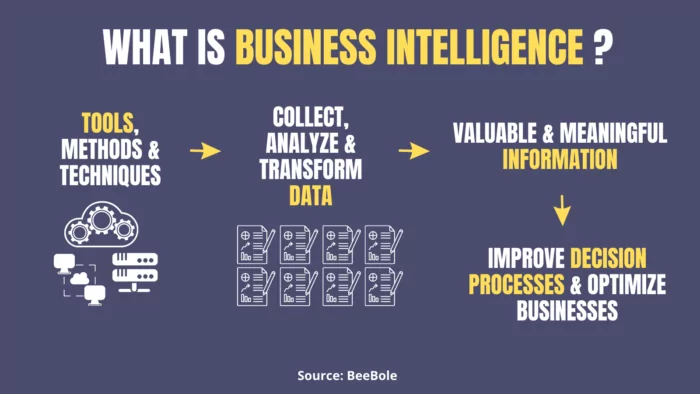
What else can business intelligence do?
Apart from improving your decision making processes, there are many powerful reasons that justify an investment in this kind of technology. Let’s see how BI can help you run a smart company.
Business intelligence can:
- Help you make sense of the data your business collects.
- Uncover and reveal problems, patterns, and opportunities.
- Improve your forecasting and tracking processes.
- Optimize your business operations.
- Help you move faster and more accurately.
- Enable users to generate actionable business insights.
- Allow you to stay competitive in the market.
- Save you money and eliminates inefficiencies.
- Create a common vision for everybody in the organization.
While these advantages are general, business intelligence addresses different areas in very specific ways. Let’s see how business intelligence software improves the following key business areas:
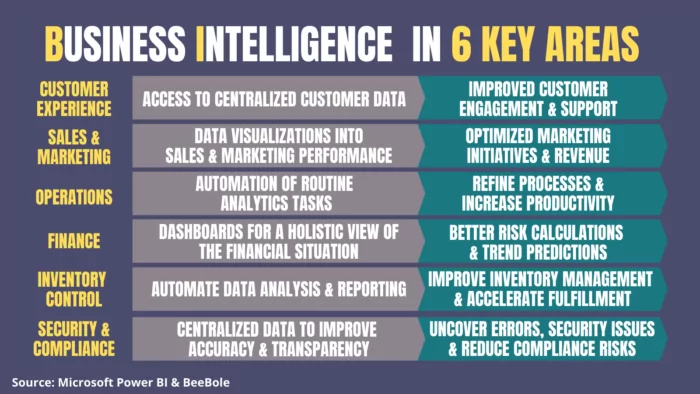
But what kinds of tools, methods, and programs are used to collect, analyze, and transform data into valuable business information? Let’s take a look at some of the most popular and powerful business intelligence technologies in the market.
BI tools: An overview
Generally speaking, when we talk about business intelligence tools or business intelligence software, we are talking about tools that allow companies to create value from big data. Let’s get familiar with the large variety of BI software that is available in the market. The following list provides an overview of the kind of technology and business intelligence solutions provided by today’s top BI tools:
- Digital dashboards
- Data visualization software
- Reporting and querying software
- Online Analytical Processing (OLAP) tools
- Self service business intelligence
- Cloud / SaaS / business intelligence software
- Mobile BI software
- Embedded BI software
- ETL (extract, transform and load) software
- Self service data preparation software
- Data mining tools
- Data warehousing tools
- Decision intelligence
- Business performance management
- Unified modeling language
- Local information systems
While some of this technology is self-explanatory, we anticipate that a few of the terms we just mentioned may be new for you. Because of this, we would like to clarify some of them with the following brief glossary.
Business intelligence glossary
- Cloud / SaaS / BI Software: A delivery model that allows companies to use business intelligence tools without the need for installing, operating and/or maintaining such tools on site. This technology is usually a subscription-based service.
- Data mining: A process aimed at discovering and extracting patterns from large amounts of data.
- Data warehousing: A process of putting together and organizing big sets of data into one common place.
- Embedded BI software: A process that incorporates BI software features such as data visualizations and dashboard reporting into an application.
- ETL software: Software used to combine, clean and profile data from various sources.
- OLAP: Software that enables multidimensional analysis at high speeds on large volumes of data.
- Self service business intelligence: An approach that allows business users to access and analyze data without the support from IT experts.
- Self service data preparation software: Software that allows businesses to prepare and clean data without the need of IT support.
- Unified modeling language: A visual language that is used by IT experts to define the behavior and structure of a system.
It’s important to note that most of the tools we are about to discuss in the next section combine several of the features we’ve highlighted. For instance, a platform such as Microsoft Power BI offers dashboards, reporting software, and mobile BI software, among other business intelligence capabilities.
Let’s see what are the most important business intelligence features and tools in the market.
What are the main steps to implement BI?
Before we talk about features and tools, it is important to understand how business intelligence implementation works. In order to do that, we would like to mention the 5-step process highlighted by TechTarget’s “Ultimate Guide to Business Intelligence in The Enterprise.” From loading data into data warehouses to empowering decision support systems, the following are the main steps of a business intelligence process:
- Data is integrated and loaded into data warehouses.
- Data sets are organized into analytic data models (OLAP) to prepare them for analysis.
- Business analytics and BI professionals run queries against the data.
- Query results are built into dashboards, data visualizations, and reports.
- Business leaders and employees use the information for decision-making and strategic planning.
Now that we know how BI works, it is time to see the kinds of functions and features that business intelligence technology provides to companies.
What do business intelligence tools do?
When it comes to features and functions, business intelligence technology is quite generous.
The following list, based on Capterra’s “BI Software Features Tree“, gives us a good idea of the most popular features provided by top business intelligence software applications. The percentage next to each feature indicates the presence of that particular feature among the top 20 business intelligence products featured in Capterra:
- Data analysis and analytics (100%)
- Ad hoc reports (100%)
- Dashboards (100%)
- Performance metrics (95%)
- Data visualization (90%)
- Ad hoc query (90%)
- Ad hoc analysis (85%)
- KPIs (85%)
- Budgeting & forecasting (70%)
- Benchmarking (65%)
- Profitability analysis (65%)
- Trend/Problem indicators (60%)
- Strategic planning (60%)
- OLAP (60%)
- Predictive analytics (55%)
Following this list, a survey carried out by SelectHub among business leaders showed that basic business intelligence features are the most desired by the majority of industry experts and professional users. The survey’s respondents were particularly interested in the dashboarding and visualization features.
This has been found to be quite true, especially for small-sized companies that cannot afford enough resources for BI technologies. An article published in Capterra about business intelligence features for small businesses identified three essential features for small businesses:
- Dashboards
- KPIs
- Ad hoc queries
Along those lines, TechTarget’s “Ultimate Guide to Business Intelligence in The Enterprise” lists the following as the most important functions of today’s BI platforms:
- Business monitoring and measurement
- Data analysis and analytics
- Reporting and information delivery
- Predictive analysis
But what are the BI tools that offer those kinds of features? What are some of the most popular business intelligence systems in the market? Let’s take a look.
Examples of BI tools
When it comes to business intelligence trends, the enormous growth of business intelligence systems is by far one of the most significant ones. This may be intimidating when you are trying to choose the right tool for your organization. However, this dramatic increase has come together with lower software costs, which have favored the adoption of BI tools across all kinds of organizations.
Every year, Gartner publishes the “Magic Quadrant for Analytics and Business Intelligence Platforms,” a special report that lists the top business intelligence tools in the market. (You can sign up to download their original research here.) In the following image, you can see the most popular tools and platforms as of February 2021:
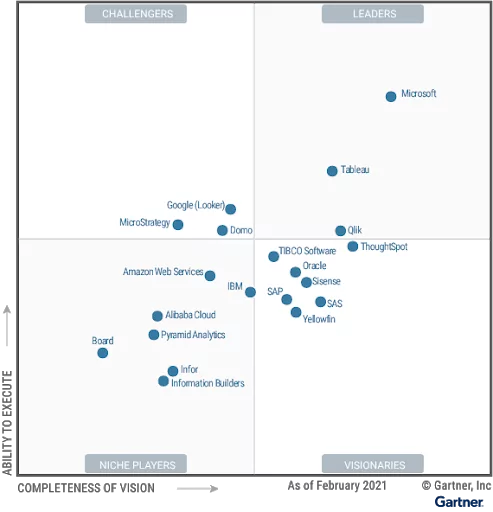
Considering the above image, the following list provides information about some of the most popular BI tools in the market and their key features:
- Microsoft Power BI (data preparation, visual-based data discovery, interactive dashboards, business analytics solutions).
- Tableau (data visualization, business analytics solutions, dashboards).
- Qlik (data analysis, data integration, augmented analytics, dashboards).
- Google (Looker) (data analytics, reporting, dashboard).
- MicroStrategy Analytics (customized dashboards, data analytics tools, reporting).
- Domo (data visualizations, dashboards).
- TIBCO Software (analytics in dashboards, interactive visualization, data preparation).
- Oracle (data ingestion, augmented analytics, visualizations, dashboards, reporting, mobility).
- IBM (business analytics, enterprise reporting, data visualization).
- Sisense (business analytics, data visualization).
- Winpure (data cleansing and deduplication solutions. Their tools help businesses improve data quality, remove duplicates, and enhance accuracy).
Note that we’ll cover many of these tools in-depth below.
What are the main outcomes of using BI software?
All the features and tools that we mentioned before empower companies to do a whole variety of things. The following list from Klipfolio provides a nice overview of some of the things that companies can do with their BI tools:
- Analyze customer behavior, buying patterns, and sales trends
- Measure, track, and predict sales and financial performance
- Budgeting and financial planning and forecasting
- Track the performance of marketing campaigns
- Optimize processes and operational performance
- Improve delivery and supply chain effectiveness
- Implement web and e-commerce business analytics
- Measure customer relationship management
- Carry out risk and strategic value driver analysis
Evidently, the way business intelligence is used depends a lot on the kind of companies or industries we are looking at. In the following image, we can see how certain industries apply business intelligence in order to reach some very specific goals.
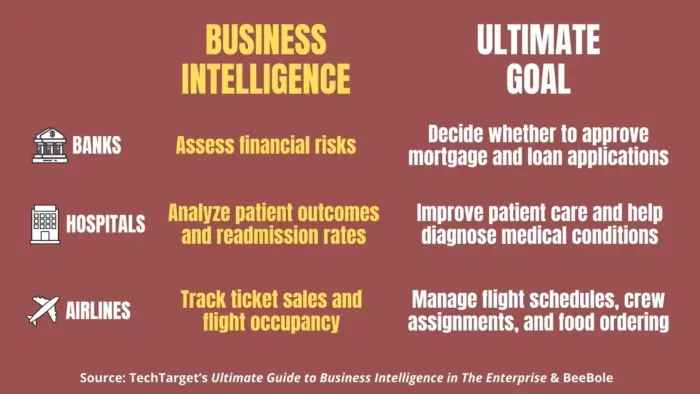
Despite all the benefits that business intelligence offers to companies, business intelligence serves goals that go way beyond the boundaries of the corporate world. In fact, business intelligence has emerged as a great tool to fight some of the main problems that affect our world.
One of the most noticeable examples of this is the Tableau Foundation, an initiative created by employees of the popular platform that encourages the use of data, facts, and analytical reasoning to solve problems such as racial injustice, hunger, homelessness, and gender inequality.
When it comes to combating hunger, for example, Tableau has forged a partnership with Feeding America, the largest hunger-relief organization in the United States, that has significantly improved the ability of this organization to implement data-driven solutions. “[Tableau] allows us to provide better support to food banks. It also allows us—as a whole network—to advance our analytics to provide more in-depth and more flexible analysis to the different kinds of questions people across the network might be asking about the work we’re doing,” explains Stephanie Zidek, Director of data and analytics at Feeding America.
10 best business intelligence tools and solutions
Choosing the right business intelligence software is something that depends on the needs of your business. Are you looking for a business intelligence software empowered with interactive data visualizations, or are you looking for a tool that allows you to implement well-detailed financial data analysis?
While each business’ needs are diverse and unique, there are some business intelligence tools that are very effective across a large number of industries and fields. Let’s take a look at the top 10 business intelligence tools every company needs to know about. For each BI tool, we’ll provide a short introduction followed by a list of pros and cons, as well as a summary of a successful case.
1. Beebole
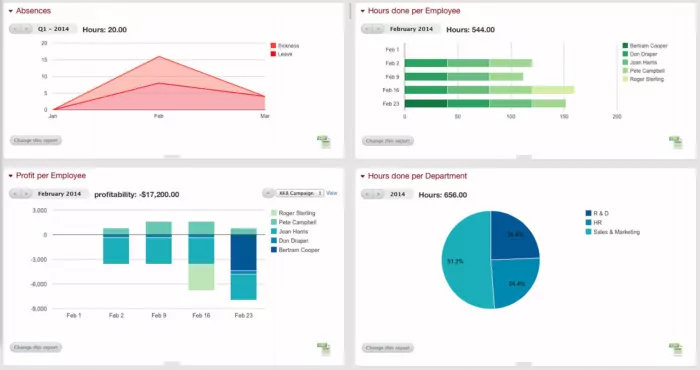
If you are looking for simplicity, a tool like Beebole may be just what you want. Their project time tracking solution is also a surprisingly powerful business intelligence tool, offering customizable KPI dashboards and reports that you can build to make smarter business decisions.
Pros:
- Simple and intuitive
- Offers a mobile app that works offline
- Economical
Cons:
- Complete admin settings only available on web/desktop version, not mobile (only for employees)
The Cloud Perspective, a UK-based data consultancy, needed a way to turn raw operational data into actionable business intelligence. With Beebole’s customizable reporting and export features, they can now:
🚀 Transform time tracking data into BI-ready dashboards and KPIs
🚀 Analyze productivity at both the individual and company-wide level
🚀 Export raw data for deeper analysis and integration with other BI tools
🚀 Gain real-time visibility into costs, profitability, and resource allocation
“I love the ability to look at the productivity of individuals or the entire business, and the fact that the data is readily available in graphs, tables, charts, etc. Through the export and API I can download the raw data for analysis.” — Miranda Pocock, Founder, The Cloud Perspective
The Cloud Perspective case:
This data consultancy has been using Beebole to record the working time of its consultants. However, Beebole’s impact on the organization has gone far beyond that. “I love the ability to look at the productivity of individuals or the entire business, and the fact that the data is readily available in graphs, tables, charts, etc. And that through the export and API I can download the raw data for analysis,” states Miranda Pocock, founder of the company.
Project Time Tracking Data for Better Business Intelligence
2. Microsoft Power BI
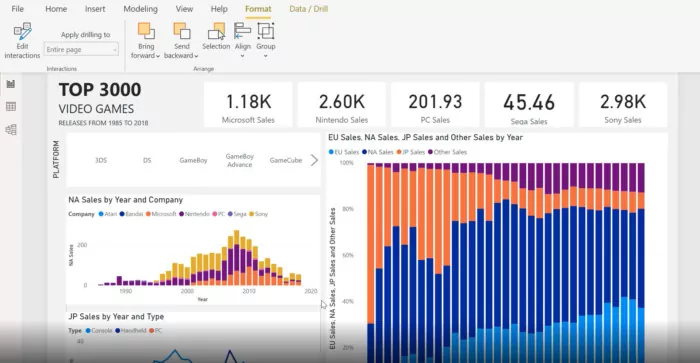
If you and your team work with Microsoft products like Office, SharePoint and SQL server, this is one of the top business intelligence solutions you may want to consider for your business.
Microsoft Power BI offers data preparation, visual-based data discovery, interactive business dashboards and augmented analytics. This makes Power BI an excellent choice when it comes to tasks like planning and budgeting. Apart from that, one of its distinctive advantages relies on the fact that this BI tool is available both as a SaaS option (via the Azure cloud) or as an on-premises option.
Pros:
- Top visualization capabilities (including real time visualizations)
- Integrated with Microsoft products
- Access on web and mobile devices
- Convenient price
- A product with an ambitious scope towards the future
Cons:
- The on-premise offering doesn’t provide the business intelligence capabilities of the cloud solution.
- Limited to Azure
- Limited customization
The Wonderful Company case:
The Wonderful Company had several problems regarding data management especially because every department was using its own reporting tools and business data was simply disconnected. Thanks to Power BI, the company was able to add more data sources, deliver more KPIs and implement dashboards that were capable of simplifying and breaking down data.
3. Qlik Sense
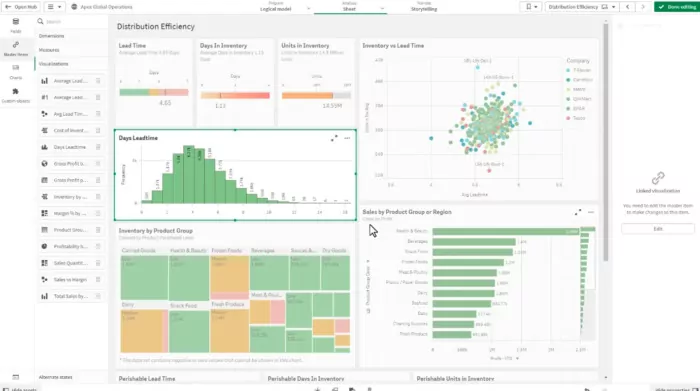
Qlik is one of the most well known names in the business intelligence world. In particular, its lead ABI solution, Qlik Sense, is a popular data analytics platform tool that is enhanced by the power of artificial intelligence.
Pros:
- Easy to use in terms of reporting and data visualizations
- Ability to connect to multiple data sources
Cons:
- Limited chart customization
- Some functions (analytics) are not easy for non-technical users
- Can be an expensive option
- The overall range of Qlik products is not cohesive
The Aramark case:
This gigantic food, facilities, and uniform services provider has taken advantage of Qlik Sense’s artificial intelligence capabilities to run a more effective business. For instance, Qlik Sense has allowed Aramark to reduce overtime hours and food waste while improving its forecasting capabilities.
4. Looker
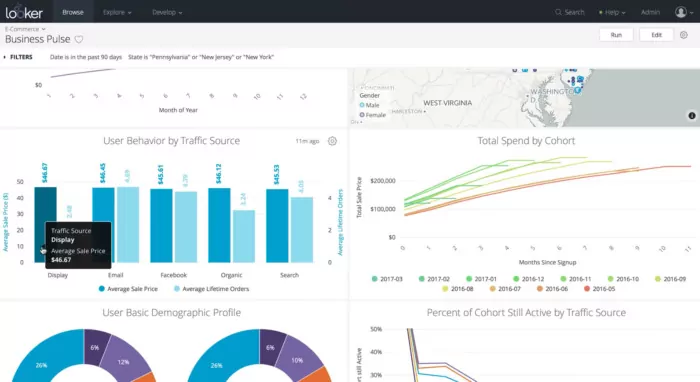
Since its acquisition, Looker has become Google’s main bet in the business intelligence universe. This BI software is well known for its Business Intelligence reporting tools and dashboard capabilities.
Pros:
- Easy to use dashboards and reports
- Convenient drag and drop dashboard creation
- Good customer support
Cons:
- Some functions are designed for technical users (data modeling)
- It doesn’t offer important business intelligence capabilities such as AI and augmented analytics experiences
- Limited presence outside the U.S., Europe and Japan
The Get Your Guide case:
With more than 15 millions users per month, Get Your Guide is the largest platform for booking travel experiences. Thanks to the adoption of Looker, the company was able to establish a data-driven approach to business that ended up improving the performance of all the different teams within the organization, as well as the user experience.
5. Tableau
When it comes to data visualization and analytics, it is hard to find a better alternative than Tableau. In fact, Tableau is a business intelligence platform that is widely embraced for its wide variety of features, including visualizations, dashboard and reports. This business intelligence software is one of the best on the market because it is both powerful and intuitive.
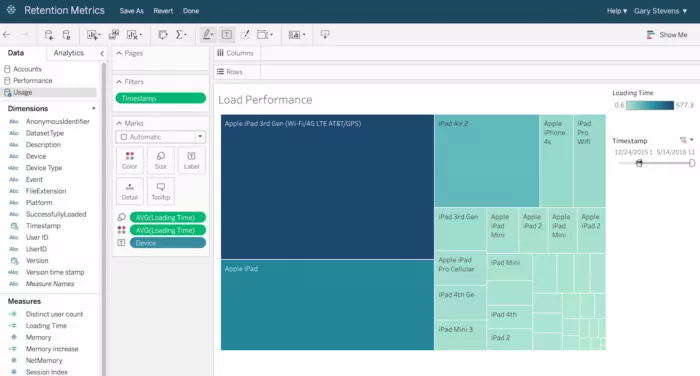
Pros:
- Easy to use
- Great flexibility in terms of visualizations
- Intuitive data analytics experience
- High level of usability thanks to an intuitive interface
Cons:
- Expensive when compared to other business intelligence solutions
- Lack of cloud-native architecture for on-premises customers
The Allrecipes case:
As the world’s largest digital food brand with a community of 85 million cooks worldwide, Allrecipes knows how important it is to manage data properly. Thanks to Tableau, “Allrecipes can understand every stage of the customer journey. From analyzing web analytics to tracking content engagement, visual analysis allows them to spot and stay on top of emerging trends. Visibility into customer and web analytics helps Allrecipes reach dominant audiences like millennials, establishing a competitive advantage in the digital landscape.”
6. Tibco Spotfire

Thanks to its capability to process large amounts of data, this business intelligence tool is one of the best data discovery and interactive visualization tools in the market. Because of that, Tibco Spotfire is an ideal tool for data-intensive organizations looking to implement advanced analytics and identify critical insights.
Pros:
- Very good for complex and advanced analytics and data models
- High scalability
- Scripting language support
Cons:
- Not very popular when compared to competitors
- User interface is a bit different from the market standards, which affects the learning curve
- Expensive and limited in terms of contract flexibility
The Aeroporti di Roma case:
The adoption of Tibco by the Fiumicino Airport in Rome has played a crucial role in the business performance of this hub even during the pandemic. “Like many other businesses managing the economic impact of the pandemic, cutting costs is top of mind for driving profitability. With TIBCO, the airport was able to analyze which areas of the airport should stay open and which should close for maximum safety, customer satisfaction, and operating efficiency. These analyses led to Aeroporti di Roma to reduce nearly 40 percent of its day-to-day operating costs while continuing to provide a high-quality passenger experience.”
7. MicroStrategy
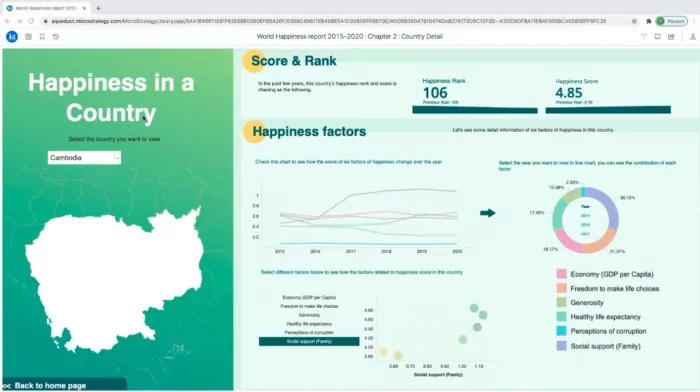
MicroStrategys is a business analytics software that enables users to build self-service dashboards, create highly-formatted reporting, and perform sophisticated data analysis. Apart from its visualization capabilities, MicroStrategy also supports data mining.
Pros:
- Outstanding business intelligence reporting
- Good technical support
- Drag and drop canvas for visualizations
- High stability and security level
Cons:
- Technical knowledge necessary
- Dashboard creation not as intuitive as other tools on the market.
- Lacks Natural Language Generation (NLG) and automated insights
The Pfizer case:
Before adopting MicroStrategy, Pfizer had two big problems in terms of business intelligence: speed and consistency. Thanks to the partnership they created with MicroStrategy, Pfizer was able to put together a suite of tools that enable everyone in the organization to work around a consistent database. Along those lines, everyone was empowered to create reports and interactive business dashboards aimed at meeting their most specific needs.
8. Sisense
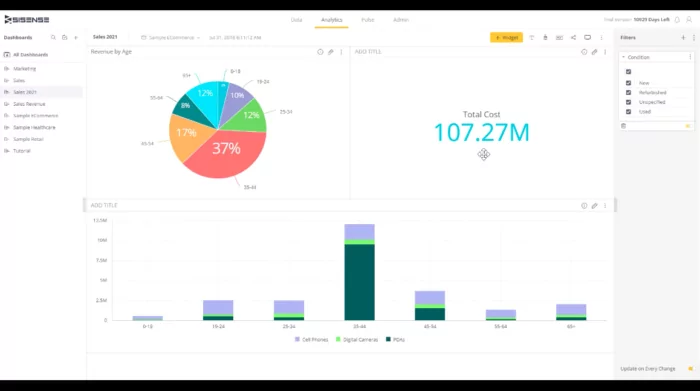
In recent years, Sisense has gained popularity in the market not only because it is an easy-to-use business intelligence software, but also because of its ability to integrate multiple data sources. Because of this, Sisense is an ideal tool to use with complex data projects. Data preparation, visual exploration and augmented analytics are some of Sisense’s strongest Business Intelligence capabilities.
Pros:
- Easy to create dashboards
- Solid cloud and NLQ capabilities
- Multi-cloud capable
Cons:
- Not as popular as other business intelligence platforms on the market
- Limited mobile capabilities
- Lack of flexibility in terms of admin permissions
- Complex product packaging
- Focused on the development ecosystem rather than consumers
The CTSI case:
Every day, CTSI, a freight audit and payment services provider, processes between two and four million of freight invoices. Because of that, CTSI was looking for a business intelligence tool that was able to provide its customers with a good view of their transactions. They opted for Sisense because of how easy it is to implement and embed in their TMS application. Plus, customers are able to create their own dashboards providing CTSI with valuable information regarding its own customers.
9. Domo
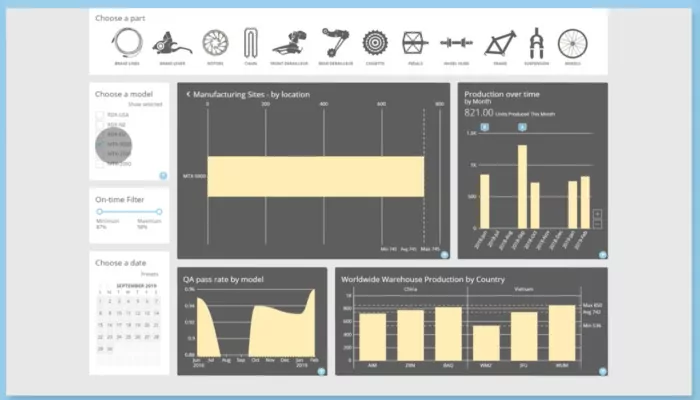
This self-service, cloud-based business intelligence tool provides data analysis, insights, and predictive analytics in a very intuitive way. In fact, you don’t need to be an expert if you want to customize visualizations and build dashboards. Domo is a powerful tool that provides various business intelligence capabilities ranging from data warehouse and ETL to visualizations and reports.
Pros:
- Easy to use and focused on consumer design
- Ongoing dramatic growth on the market since 2019
- Fast connectivity to enterprise applications
Cons:
- Lacks own application ecosystems and cloud platforms
- Limited in terms of geographic presence
- Not the best price on the market
The Traveloka case:
Like many businesses, this app was heavily hit by the pandemic. However, that didn’t mean that work slowed down. On the contrary, the team was busier than ever trying to cope with cancelations, refunds and reschedules.
At this particular moment, the company used Domo to track key customer metrics, balance the workload of various teams across the organization, and carry out contribution and cluster analysis. “With Domo, we were able to make fast, accurate decisions while managing a 10x increase in traffic to our customer care team without adding resources,” said Gumarus Dharmawan William, Traveloka’s Product Manager.
10. Yellowfin
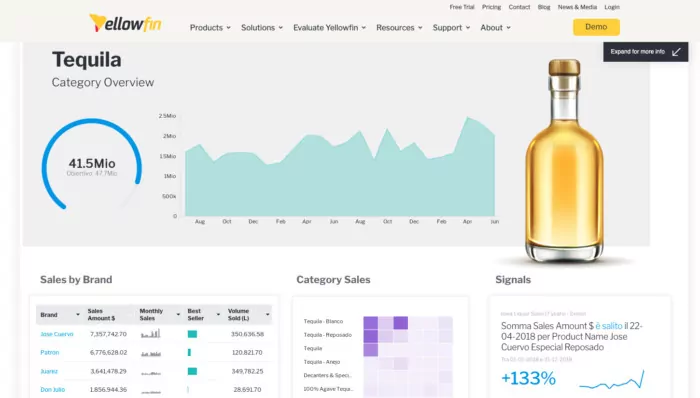
According to Gartner’s “Magic Quadrant for Analytics and Business Intelligence Platforms,” Yellowfin is one of the top business intelligence tools on the market in terms of innovation. Originally conceived as a reporting and data visualization software, Yellowfin has expanded its offer with additional business intelligence capabilities such as data preparation and augmented analytics.
Pros:
- Very innovative
- Wide range of functionality
Cons:
- Not a top product on the market compared to competitors
- Very limited geographic presence
The University of Konstanz case:
In the past, the University of Konstanz had unstructured data all over the place and reporting was extensively based on paper and excel. However, that changed with the arrival of Yellowfin whose “intuitive business intelligence solution has enabled a broad range of academic and business decision-makers to access and independently analyze a single reliable source of data – anywhere, anytime from any device.”
Without any doubt, the business intelligence tools we just reviewed are among the best business intelligence software available. However, there are a plethora of other BI tools that could be of interest for you, your goals and your business. The following image offers two other lists of top BI software currently on the market.
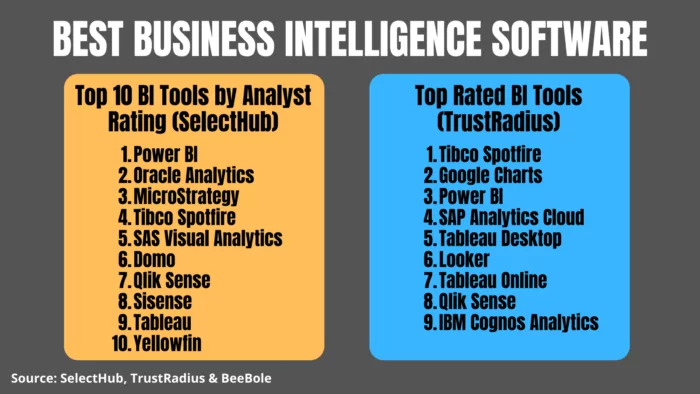
It’s clear that there are lots of powerful BI solutions on the market nowadays. Choosing the right one will depend on the needs of your business. Remember that the question is no longer whether or not to use a business intelligence tool, but rather which BI tool is right for your organization. If you truly want to transform raw data into gold, you need to answer that question with the best business intelligence software for your organization.
More real-life examples of business intelligence
In order to see the practical side of it, we would like to wrap up this article with a couple of examples where you can see the impact that business intelligence can have in different fields and organizations.
In the non-profit field
Because of the funding they receive, non-profit organizations need to be very effective in terms of accountability and transparency. In this example, the Kentucky Museum of Art and Craft, a non-profit organization, decides to effectively track all the activities it runs. In order to do that, they decided to bring a timesheet system with BI capabilities into their business operations.
Thanks to this system, the organization is able to accurately track the time of all its staff and, thus, the time and true cost associated with each one of the activities it runs. With this BI solution, the organization is able to improve its decision processes and manage its budget effectively.
If you want to have more insights from this real-world example, we invite you to check out our interview with Aldy Milliken, Director of the Kentucky Museum of Art and Craft.
In the retail sector
Let’s imagine you have a clothing store that has both physical and virtual shops: your business offers a membership card, which users must use every time they buy something from your stores and/or e-commerce platform. Each time a customer uses his/her card, your system collects data about that particular customer and his/her transaction.
There are thousands of transactions taking place in your shops, and the amount of business data collected in your system is enormous. At this point, you decide it is time to bring a business intelligence (BI) solution into your business.
Thanks to business intelligence, you are able to run analytical reports on all the data you have collected from your customers. As a result, you are able to understand several things, including the following:
- The level of loyalty of your customers.
- The most popular products in your stores.
- How frequently customers buy products from you.
- Their preference in terms of physical vs. online shopping.
With this kind of information in your hands, you can understand or even predict your customer’s needs, preferences, and habits. You can also anticipate new opportunities, deliver better customer service, and optimize your marketing campaigns.
In other words, your business intelligence solution provides you with valuable insights regarding your customer’s historical transactions and behaviors, something you can use to improve your services, increase your sales, and differentiate your brand.
It’s all about this: Business intelligence insights
We have covered some of the specific things companies can do with their business intelligence tools. However, from a broader perspective, the ultimate goal of business intelligence is that of helping companies to make well-informed, data-driven, strategic business decisions. When companies are able to do that, they can enjoy the following benefits:
- Take control of the business data generated by the company
- Answer specific business questions effectively
- Improve decision-making processes
- Identify inefficient processes within the organization and improve business knowledge
- Gain a better understanding of business operations and challenges
- Increase productivity
- Identify market trends and opportunities
- Implement strong business strategies
- Boost sales and revenues
- Gain market advantage
As you can see, business intelligence technology is a powerful ingredient of today’s corporate world and beyond. If your business manages lots of data, but you are not making anything out of it, it may be the right time to implement a business intelligence strategy into your organization.
Photos: Beebole






Very good article on BI , can you please provide few case study on Airport operations and who all are leaders in implementing and consultancy services
Great BI helps businesses and organizations ask and answer questions of their data. Business intelligence can help companies make better decisions by showing present and historical data within their business context.
Exactly, Rich. It’s absolutely key in the decision making process today.